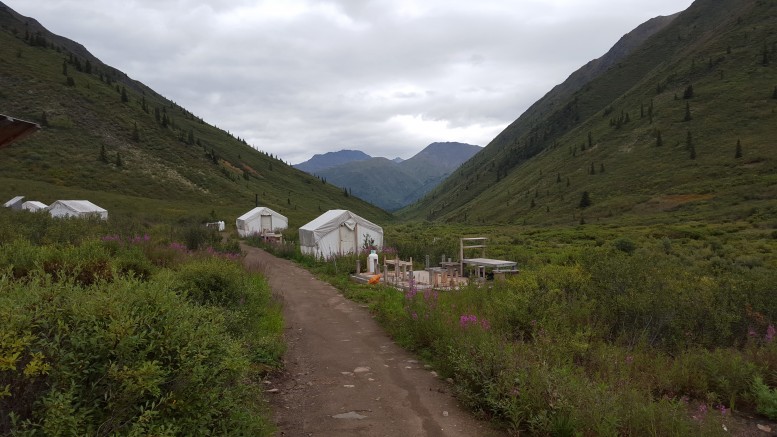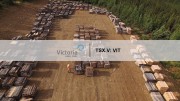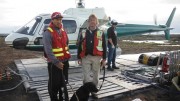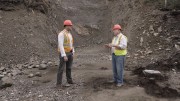VANCOUVER — Explorer Atac Resources (TSXV: ATC; US-OTC: ATADF) thinks its high-grade Tiger oxide gold deposit could offer significant start-up cash flow for a large-tonnage operation at its massive Rackla project, 55 km northeast of Keno City in the central Yukon.
The company released an updated preliminary economic assessment (PEA) on Tiger in May and hopes positive results from an upcoming $3 million exploration campaign on two early-stage targets could attract further financing, or a strategic partner.
One of Atac’s main concerns at Rackla is a lack of infrastructure, since the project covers 1,700 sq. km of wilderness that isn’t road accessible.
The company has made headlines by finding Carlin-style gold mineralization across the regional Nadaleen and Rau trends, but Tiger is intriguing because it is near surface, and the company could build a road to the deposit relatively easily.
Atac last released a PEA on Tiger in 2014, but the economics have improved due to a lower Canadian dollar and some tweaks to the mine plan, including steepening of the pit walls, and including transitional and sulphide material that had previously been classified as waste.

The Tiger zone at Atac Resources’ Rackla gold property, 55 km northeast of Keno City in the central Yukon. Credit: Atac Resources.
The study models a US$109 million operation that would crank out 302,307 oz. gold over a four year mine life. Assuming a US$1,250 per oz. gold price, the plan features a US$76 million post-tax net present value at a 5% discount rate and a 28% internal rate of return. Tiger’s overall measured and indicated resources are 5.7 million tonnes of 2.66 grams gold for 485,700 contained oz. gold.
“The big upside for us could be the Airstrip anomaly right beside Tiger,” president and CEO Graham Downs says during an interview. “We have the nice low-hanging oxide opportunity established, which is great, but we want to enhance that with something close by. Frankly, we have this really promising anomaly we discovered at the end of last year. There are above-average gold values all over the area, and I’m optimistic it could represent a big, bulk-tonnage deposit that would give us the critical mass we need.”
The 10 sq. km Airstrip target was outlined during wide-spaced soil sampling at the Bengal showing, 3.2 km south of Tiger. Bengal occurs within a broad, intermittent gold-in-soil geochemical anomaly hosted within a package of variably calcareous siltstone sediments in a lower slope to basinal stratigraphic setting. Airstrip was defined by samples that returned up to 1.03 grams gold-in-soil.
“We’re about to put in an application for a tote-road permit, and now we need to decide if we want to proceed through to feasibility. It will be a pretty short jump because we already have this engineered to a pretty high level. We’re confident in a lot of these numbers based on our work,” Downs says.
In April, Atac closed a $3.3 million private placement wherein it sold 5 million flow-through shares priced at 65¢ each.
The proceeds are earmarked for an initial exploration program that will focus on Airstrip and the Orion discovery at the Anubis Cluster, where the company cut 47 metres of 3.79 grams gold from 15 metres deep in hole 15-026.
“In terms of our Carlin-type targets, we’re zeroed in on Orion,” Downs says. “We literally have one hole in the thing, and we need to look at near-surface targets to build that critical mass because we either need to keep raising capital to drill, which is expensive, or we need to attract a partner to go in and do the heavy lifting.”
The initial exploration program will include 30 rotary air-blast holes at Orion and additional geochemical coverage at Airstrip. Atac will also move ahead with permitting the 69 km road through to the Rau trend and Tiger.
Atac has traded in a 52-week range of 25¢ to 88¢ per share, and jumped 161%, or 48¢ over the past six months to a 77¢ close at press time. The company has 118 million shares outstanding for an $89.6 million market capitalization, and reported $19 million in its treasury at the end of April.
“Quite honestly, if we have a lot of success at Airstrip I’d be tempted to focus all of my efforts there. It’s closer to infrastructure and the size potential is there,” Downs says. “That said, if you put a hole near Orion, and the mineralization carries, the plan can change.
“We’d like to back up where we are with some assays before we go back to the market. I expect we’ll find some drill joy out there that will give us the ability to finance at a much less dilutive rate. If things go the way I hope, we’ll be drilling a lot more this year.”






Be the first to comment on "Atac eyes road access to Tiger gold deposit in the Yukon"